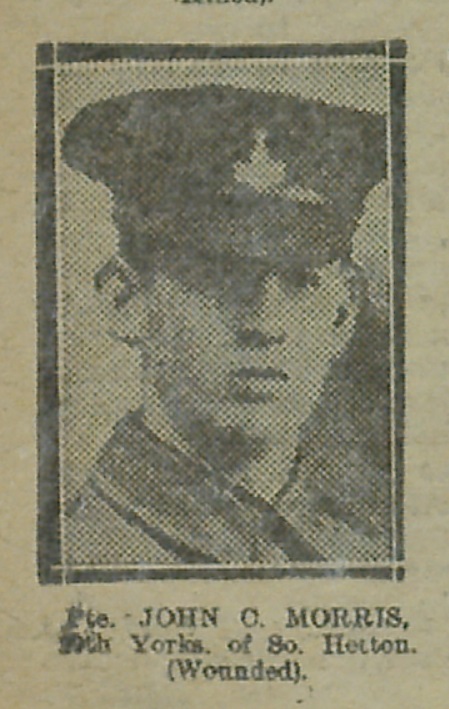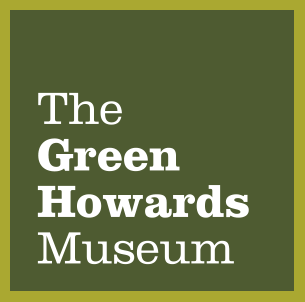
John Charles Morris was from South Hetton. He was born in 1896 and was 18 when he enlisted in the Yorkshire Regiment as 14136 Private Morris. He served in the 8th, 9th and 10th Battalions and was awarded the 1915 Star, the British War Medal and the Victory Medal, as well as the Silver War Badge.
He was wounded in December 1915 and again in November 1916. He suffered a gun shot wound to his left hand and lost part of a finger and substantial power and movement in his right hand. He also suffered a shrapnel wound to his left foot.
These injuries precluded manual work due to a lack of power in his hands. After his discharge in December 1918 he was awarded a pension of 8 shillings a week and was subject to regular reassessments of his injuries.
He died aged 61 in 1957.
Explore more memories from the ribbon
-
Harold Surtees
Jonathan Helm submitted this information about his Great Grandfather, Harold Surtees. Lance Corporal Surtees (2048/200407), was born in West Hartlepool and lived in Great Ayton. He volunteered for service in a local meeting on 2nd September 1914. Serving with the 1st/4th Battalion Yorkshire Regiment, he was posted to France as part of the 50th Northumbrian Division on 18th April 1915. Although little is known of his exact war record, his photograph indicates two wound stripes and the Whitby Gazette when reporting his death noted that he had been “three times wounded and gassed”. The only confirmed record of wounding is in the War Office Casualty List, which was printed in The Times on Wednesday 25th October 1916. This is likely to have occurred during the Battle of Flers-Courcelette (15th – 22nd September 1916) which was fought during the Battle of the Somme. He died on the 10th April 1918 (aged 26) from wounds sustained when the battalion fought at the Battle of Estaires in an attempt to stop the German advance. Harold is buried at the Haverskerque British Cemetery in France. He left behind his wife, Sarah, and their two children, Harold and Mary.
-
Erasmus Darwin
Erasmus Darwin was born on the 7th December 1881 in Cambridge and lived at ‘The Orchard’. He was the only son of Horace Darwin FRS (Fellow of the Royal Society) who was Chairman of the Cambridge Scientific Society. He was also the grandson of the famous naturalist Charles Darwin. Erasmus was educated at Horris Hill School near Newbury and at Marlborough. He then went on to Trinity College, Cambridge University to study Mathematics. On leaving Cambridge he worked at Mather and Platts in Manchester, a hydraulics and pump engineering company. He then moved on to work for Bolckow, Vaughn & Co Ltd Iron and Steel in Middlesbrough, whereby, at the outbreak of the war he was Secretary of the Company. He lived at the time at Saltburn on the north east Yorkshire coast. As soon as war broke out he joined up and was gazetted on the 12th September 1914 as a 2nd Lieutenant the 4th Battalion Yorkshire Regiment. Apparently just before he left England he was summoned to the War Office and offered a Staff appointment at home in connection to munitions work. Though the work was important he opted to stay with his unit making the case that there were plenty of older men equally qualified for the work. The 4th Battalion arrived in France on the 18th April 1915 and were straight away into the 2nd Ypres offensive which started on the 22nd April. The Battalion was involved in the Battle of St Julien in the heart…
-
Robert Baden Powell
Submitted by Neil Duncan of the 8th Darlington (Cockerton Green) Scout Group. Lieutenant-General Robert Stephenson Smyth Baden-Powell, 1st Baron Baden-Powell, OM, GCMG, GCVO, KCB, DL was born in 1857 and had a long and illustrious military career, as well as having a profound impact on civilian life for generations of young people. Baden-Powell spent most of his military service in India and Africa where he honed his Scouting skills and began writing training manuals which would later be the basis for the Scouting Movement from 1908. One of his most famous commands was during the Seige of Mafeking in 1899 when a small garrison held out for 277 days and a ‘Cadet Force’ was drawn up take over small but important jobs to allow the adults to fight. These Cadets gain an honourable mention in the opening chapter of Scouting For Boys. He returned to England to take up a post as Inspector-General of Cavalry in 1903. From 1908-10 he was in command of the Northern Territorial Army. During this appointment, Baden-Powell selected the location of Catterick Garrison to replace Richmond Castle which was then the Headquarters of the Northumbrian Division. His plan was brought to fruition following the outbreak of the First World War. The original concept was for a temporary camp to accommodate 2 complete divisions, 40,000 single men in 2,000 huts. On the outbreak of World War I in 1914, at the age of fifty-seven, Baden-Powell put himself at the disposal of the War Office. Lord Kitchener…
